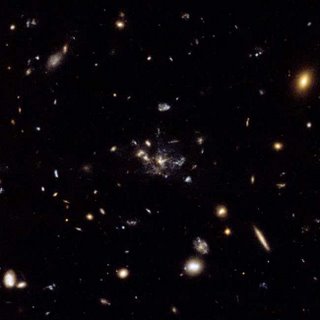
More interesting news from Space.com, research to be published in ApJL by Miley et al. (2006) used the HST ACS to look at a forming galaxy cluster at z~2.2.
They found the galaxy in the centre of the image above (which they call the spiderweb galaxy) to be made up of about 10 smaller clumps, which are believed to be smaller star forming galaxies in the process of merging. This galaxy seems to be a progenitor for a large cluster dominating cD galaxy, like the ones seen in the nearby Universe.
What is very interesting is the large star formation rate in the structure of 100Msun / year, with such a high star formation rate it doesn't take that long to form all of the stars in a large elliptical galaxy. This feeds nicely into my own research which involves measuring the ages of stars in large elliptical galaxies, we generally seem to see that large elliptical galaxies formed most or all of their stars before a redshift of about 1.
In conclusion everything seems to fit very well with a hierarchical merging formation for these large galaxies, exactly as we would expect.
They found the galaxy in the centre of the image above (which they call the spiderweb galaxy) to be made up of about 10 smaller clumps, which are believed to be smaller star forming galaxies in the process of merging. This galaxy seems to be a progenitor for a large cluster dominating cD galaxy, like the ones seen in the nearby Universe.
What is very interesting is the large star formation rate in the structure of 100Msun / year, with such a high star formation rate it doesn't take that long to form all of the stars in a large elliptical galaxy. This feeds nicely into my own research which involves measuring the ages of stars in large elliptical galaxies, we generally seem to see that large elliptical galaxies formed most or all of their stars before a redshift of about 1.
In conclusion everything seems to fit very well with a hierarchical merging formation for these large galaxies, exactly as we would expect.


No comments:
Post a Comment